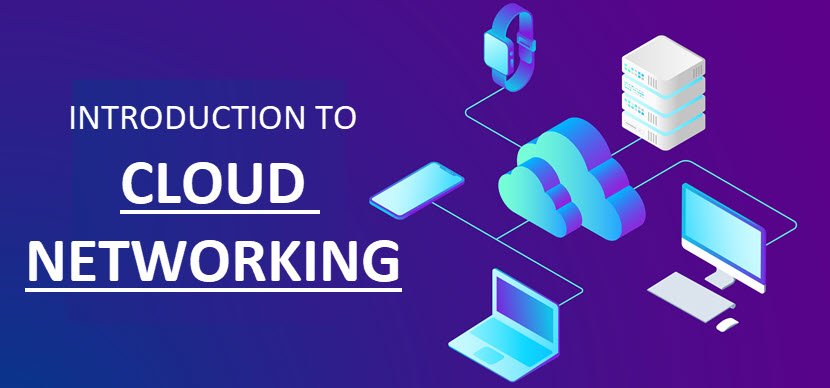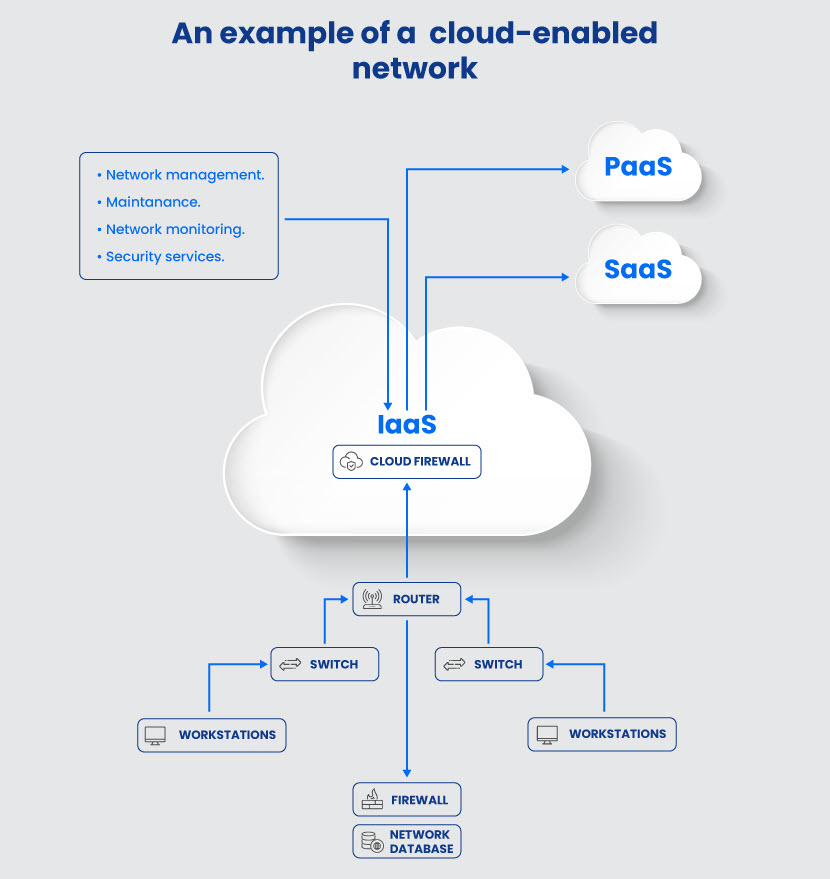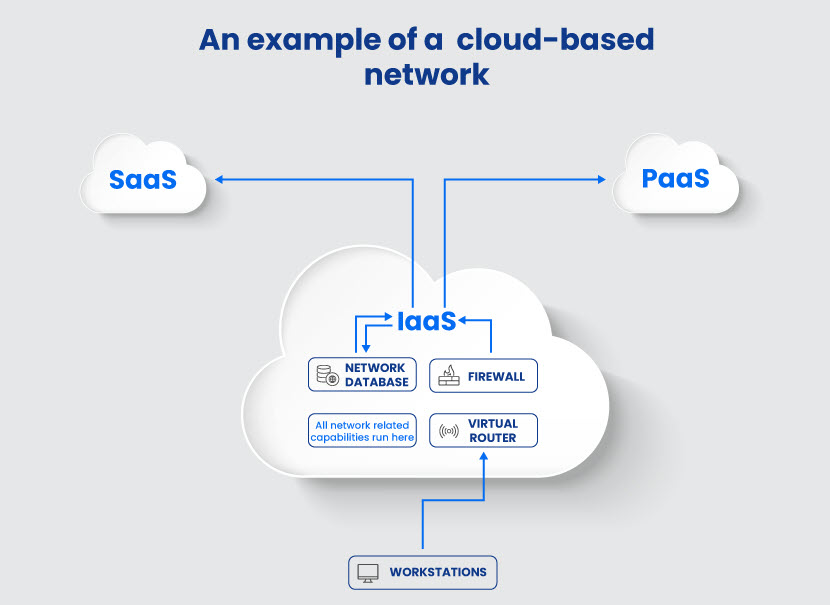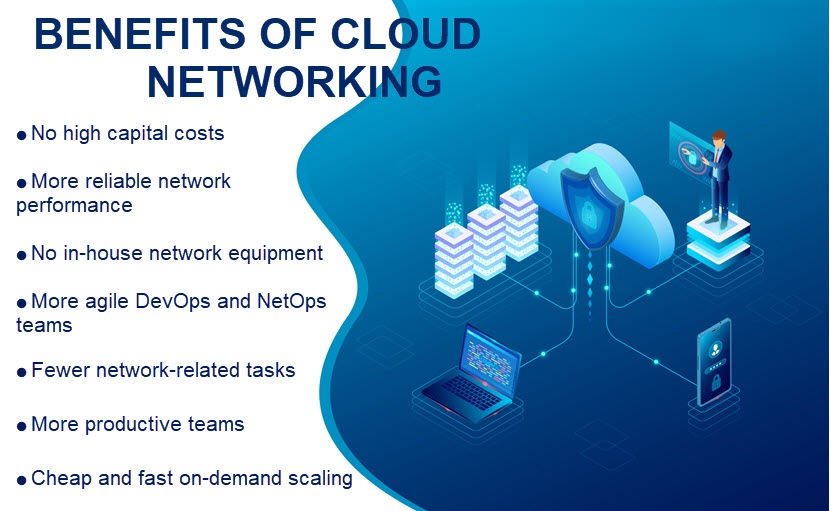Cloud networking is an IT infrastructure type that enables a company to run some (or all) network resources in the cloud. Organizations can host networking capabilities in a public or private cloud to provide connectivity between apps and workloads spread across:
- Cloud-based services (IaaS, PaaS, SaaS).
- On-premises data centers.
- Colocation facilities.
- Edge computing services.
While cloud networks may be optional for some use cases, this networking strategy is vital for efficient performance and management of hybrid and multi-cloud environments.

How Does Cloud Networking Work?
Cloud networking enables a company to design, configure, and manage network resources in the cloud. A business can create any virtual network resource the system requires, including:
- Routers and switches.
- Virtual private networks (VPNs).
- Firewalls.
- Data connectivity.
- Load balancers.
- Virtual bridges.
- Gateways.
- Content delivery networks (CDNs).
- Adapters.
- Domain name systems.
Whether managed in-house or by a cloud provider, these network resources are available on-demand as a cloud service. Teams can quickly deploy new or remove unnecessary capabilities to fine-tune and create an ideal network that matches current traffic requirements.
Companies have two options when choosing where to set up cloud-based network resources:
- Use a private cloud: Private clouds offer architects more flexibility in the overall network design. As the company fully manages the underlying hardware and software, the team can adjust the environment to meet all business needs.
- Use a public cloud: If a public cloud hosts the network, customers can control and manage the setup only in an IaaS deployment. SaaS and PaaS do not grant users control over network functions as these capabilities stay entirely within the provider's scope of responsibility.
Once set up, the cloud network offers centralized management, control, and visibility across all networking elements. If managed in-house, maintaining the network requires collaboration between different stakeholders and teams, most notably:
- Cloud architects: Team members who design the overall cloud networking strategy.
- NetOps: Staff members responsible for configuring and maintaining the network and ensuring access to apps and resources.
- SecOps: Team members in charge of network security. The SecOps team is responsible for protecting users, apps, and data across the network.
Our comparison of multi and hybrid clouds offers an in-depth look at the differences between the two deployment models.
Cloud Networking Types
There are two main types of cloud networking:
- Cloud-enabled networking.
- Cloud-based networking.
Cloud-enabled networks combine traditional on-site infrastructure with the use of cloud resources. The network architecture (packet forwarding, routing, data, etc.) runs on-premises while the network's overall management happens in the cloud. The cloud-based operations can include:
- Network management.
- Maintenance.
- Network monitoring.
- Security services.
A typical example of a cloud-enabled network is a company relying on a SaaS-based firewall to keep an on-prem network safe. Meanwhile, all traffic continues to go through physical, localized routers.

With cloud-based networking, the entire network and its software stack run in the cloud. The network does not rely on any in-house hardware or software. This setup type is vital for connectivity between different cloud apps.

Besides the two main types, we can also distinguish cloud networks based on whether they grant connectivity between multiple clouds or within a hybrid environment.
Multi-Cloud Networking
Multi-cloud networking (MCN) enables the design, deployment, and operation of a network between multiple clouds. The goal of MCN is to ensure the following capabilities across all clouds:
- Consistent networking policies.
- Robust network security and governance.
- High levels of network visibility.
- A single management point for all environments on the network (typically achieved via a SaaS-delivered control plane).
Typical use cases for multi-cloud networking are:
- A connection between a Software-defined Wide Area Network (SD-WAN) and a Secure Access Service Edge (SASE) for optimized access to an IaaS or SaaS service.
- A multi-cloud software-defined network (SDN) for app-aware policy automation between an on-prem and IaaS environment.
- App connectivity between an SD-WAN and multiple public or on-prem private clouds.
The symmetry between clouds is critical for MCN both from an operational and management standpoint. The strategy must enable a business to manage uniform routing, access, load balancing, and other network functions regardless of what cloud hosts what resource.
phoenixNAP's Virtual Cloud Routers make multi-cloud networks easier to manage and enable quick and simple deployments of private connections between different cloud providers.
Hybrid Cloud Networking
Hybrid cloud networking (HCN) enables data transfers between on-prem IT resources, private clouds, and public offerings. The term also commonly reflects connectivity between just a public cloud and an on-prem data center or a colocation facility.
HCN enables a company to keep business-critical apps and data under direct on-prem control while still using the flexibility and cost-efficiency of the public cloud for less sensitive networking tasks.
In most hybrid cloud architectures, the company runs some network processes in an on-prem private cloud and hosts others via an IaaS provider. As network consistency between clouds is critical, companies typically establish uniform network IP space, procedures, and policies between the private and public cloud.
Benefits of Cloud Networking
Switching from a traditional to a cloud network has multiple business benefits.

Lower Operational Cost
A cloud-based network is significantly cheaper than having on-site network equipment and software. There are no high capital costs (upfront investments, maintenance costs, regular hardware upgrades, etc.), plus the cloud's pay-per-use model helps avoid unnecessary overhead.
Better Network Performance
Cloud networking minimizes network downtime and removes the need to shut the system down during updates. Additionally, cloud services come with high availability, which even further lowers the chance of downtime.
Better budget flexibility also allows technical departments to make upgrades and optimize network performance in ways that would not be possible in an on-prem network setup.
More Team Productivity
Cloud networking eliminates many administrative tasks. Staff members do not need to worry about pushing hardware or software, testing, physical configuration, or maintaining the network. Instead, the team can focus on other network-related tasks and priorities.
Cloud resources also relieve NetOps and DevOps teams from managing multiple services without end-to-end policies. The result is a reduced time-to-market for service roll-out and quicker adoption of new features.
The mobility and flexibility of cloud resources also open the opportunity for an effective Bring Your Own Device policy.
To even further empower your NetOps, DevOps, and SecOps teams, set up a dedicated Bare Metal Cloud servers with full support for automated server provisioning (via API and CLI) and IaC tools.
Cheaper, Faster Scalability
Cloud networking allows a company to assess current requirements and adjust the network resources to match the current needs.
As requirements change, modifying capacity is quick and straightforward. The process also does not require adding more in-house networking infrastructure.
Traditional vs. Cloud Networking Security
Traditional IT setups are among the most secure networking models in existence. Companies get to tightly control data and sharing processes without relying on any third-party organization.
However, complete control does not mean classic setups require fewer network security measures, which is why most companies set up:
- Zero-trust security policies.
- Strict firewall rules.
- Reliable access controls.
- Robust user and employee authentication protocols.
- An intrusion detection system (IDS).
- Monitoring, anti-virus, and anti-malware tools.
In a cloud network, a third-party provider hosts networking resources, an arrangement that often raises security concerns. However, there are many security measures network architects can adopt to keep a cloud network safe. Besides classical security tactics, teams can also:
- Create and enforce cloud security policies that define cloud ownership and usage rules.
- Set up a cloud management platform for better tracking, visibility, and problem control.
- Implement data encryption (both at rest, in motion, and in transit).
- Create data backups.
- Enforce two-factor authentication.
- Create a detailed roadmap that accompanies the entire lifecycle of cloud governance.
If you decide to host network resources on a public cloud, siding with a good cloud provider is vital for security. A reliable vendor will perform frequent vulnerability scans, have sound redundancy strategies, and perform regular security updates.
Our article on multi-cloud security outlines the best practices companies rely on to keep multi-cloud environments safe.
Advantages of Cloud Networking Software
A cloud networking software helps teams design, set up, and manage a cloud network. The tool simplifies management, speeds up resource deployment, and increases visibility across all environments.
Below is a list of the main reasons why you should consider using a dedicated cloud networking tool.

High Security Across Hybrid Cloud Environments
A cloud networking software enables you to implement consistent security policies for any hybrid cloud environment. Regardless of setup complexity or where you host services and data, a tool can ensure traffic flowing between cloud apps, data centers, and end-users stays safe.
A cloud networking software helps:
- Identify DDoS and DNS attacks in real-time.
- Secure and manage APIs with distributed access and security policies.
- Set up reliable traffic controls.
- Secure app access with single sign-on rules, multi-factor authentication, and various monitoring capabilities.
Our article on cloud security threats provides an overview of the main risks a team needs to account for when protecting a cloud environment.
Simpler Cloud Migration
A cloud networking software helps minimize business impact and maintain performance throughout cloud migration. Moving resources to the cloud does not impact metrics like uptime or performance regardless of whether you are migrating:
- Workloads.
- Apps.
- Infrastructure.
- End-users (via redirects and offloads).
Additionally, a top tool will help measure real-time networking metrics of end-user performance before, during, and after migrations.
A Single Pane of Glass for All Cloud Networking Efforts
Cloud networking software centralizes network management and enables you to control all environments from the same place. A single pane of glass grants control over connectivity to all:
- Cloud services.
- Cloud apps.
- Cloud security.
- Performance controls.
- Content delivery.
For additional visibility across a cloud environment, consider setting up and using one of the top cloud monitoring tools on the market.
Challenges of Cloud Networking
While in many ways superior to traditional setups, cloud networking is not free from challenges. The most significant problems with cloud networks are:
- Vendor lock-in: Once you set up a cloud network on a specific public cloud, you may be unable to use another provider without substantial switching costs and efforts.
- The lack of control: If something goes wrong with the network on the provider's end, your team cannot control the situation. The company must wait for the vendor to fix the issue before operations can return to normal.
- Poor integrations between environments: Each integration is an opportunity for a security gap or a mistake, so poorly set up cloud networks come with a high level of risk.
You can avoid these issues by siding with a reliable service provider. A good vendor will ensure you can:
- Move workloads and services without lock-in concerns.
- Rely on high uptime and quick fixes, both defined in a Service Level Agreement (SLA).
- Integrate and connect resources without security risks.
If you side with the right provider, the only challenge of cloud networking is the overall complexity. This network type is harder to tune and manage than a network running on in-house hardware. Ensure your network admins can handle real-time upgrades, make the most out of automated provisioning, and reliably troubleshoot cloud-related issues.
Cloud Networks Lower Costs, Boost Agility, and Improve Performance
When used correctly, cloud networking can be a turning point for a business. A cloud network can reduce operational costs, enable quick and easy scaling, and reduce the likelihood of downtime. Whether you go for a fully cloud-based network or combine cloud resources with a local setup, your network performance and day-to-day management will both see improvements.



